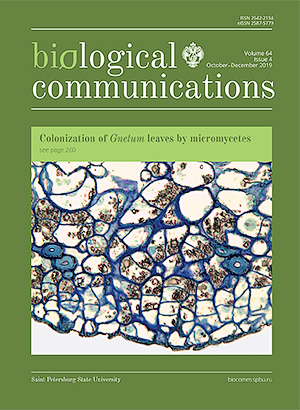Seasonal changes in the phylloplane of genus Gnetum (Gnetaceae) representatives in greenhouse conditions
DOI:
https://doi.org/10.21638/spbu03.2019.405Abstract
The leaf surface, or phylloplane, is inhabited by various microorganisms. Micromycetes are typical organisms of the phylloplane that are able to exert negative effects on plants. Seventeen species of micromycetes were indicated in the phylloplanes of G. gnemon and G. montanum. Micromycetes form biofilms on the surface of the upper epidermis. In the lower epidermis, they mainly colonize cork warts and destroy their cells. Collapsing cells and the micromycetes are isolated from the living tissues of leaves by layers of densely arranged cells. During changes from season to season, the number of disappearing micromycete species in the upper epidermis is approximately equal to the number of appearing new species. The total number of micromycete species in the phylloplane of the lower epidermis is reduced in winter. Structural organization, biodiversity, seasonal changes in the phylloplane and the influence of its micromycetes on leaf cells differ in the upper and lower epidermis of Gnetum leaves.
Keywords:
phylloplane, micromycetes, Gnetum, epidermis, cork warts
Downloads
References
Downloads
Published
How to Cite
Issue
Section
License
Articles of Biological Communications are open access distributed under the terms of the License Agreement with Saint Petersburg State University, which permits to the authors unrestricted distribution and self-archiving free of charge.





